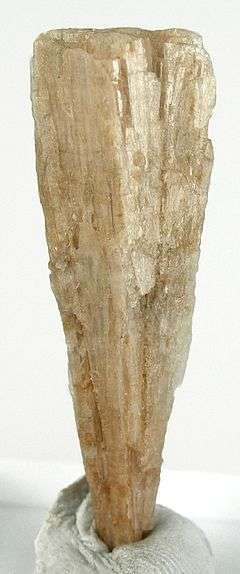Syngenite
| Syngenite | |
|---|---|
|
Tapering crystal of syngenite (size: 4.4 x 1.3 x 0.6 cm) | |
| General | |
| Category | Sulfate mineral |
| Formula (repeating unit) | K2Ca(SO4)2·H2O |
| Strunz classification | 7.CD.35 |
| Crystal system | Monoclinic |
| Crystal class |
Prismatic (2/m) H-M symbol: (2/m) |
| Space group | P21/m |
| Unit cell |
a = 9.77 Å, b = 7.14 Å c = 6.25 Å; β = 104.01°; Z = 2 |
| Identification | |
| Color | Colorless, milky white to faintly yellow due to inclusions |
| Crystal habit | Tabular to prismatic crystals, lamellar aggregates and crystalline crusts |
| Twinning | Common on {101} contact twins |
| Cleavage | Perfect on {110} and {100}, distinct on {010} |
| Fracture | Conchoidal |
| Tenacity | Brittle |
| Mohs scale hardness | 2.5 |
| Luster | Vitreous |
| Streak | White |
| Diaphaneity | Transparent to translucent |
| Specific gravity | 2.579–2.603 |
| Optical properties | Biaxial (-) |
| Refractive index | nα = 1.501 nβ = 1.517 nγ = 1.518 |
| Birefringence | δ = 0.017 |
| 2V angle | Measured: 28° |
| References | [1][2][3] |
Syngenite is an uncommon potassium calcium sulfate mineral with formula K2Ca(SO4)2·H2O. It forms as prismatic monoclinic crystals and as encrustations.
Discovery and occurrence
It was first described in 1872 for an occurrence as druse on halite in the Kalusa Salt deposit, Ivanovo-Frankovsk Oblast', Ukraine.[2] The name is from Greek 'συγγενής' (related) due to its chemical similarity to polyhalite.[3][2]
It occurs in marine evaporite deposits as a diagenetic phase. It also forms as a volcanic sublimate, as vein fillings in geothermal fields and in caves where it is derived from bat guano. It occurs in association with halite and arcanite in salt deposits; and with biphosphammite, aphthitalite, monetite, whitlockite, uricite, brushite and gypsum in cave environments.[1]
